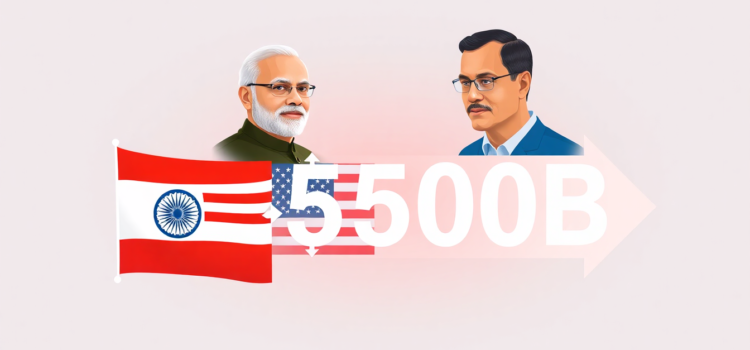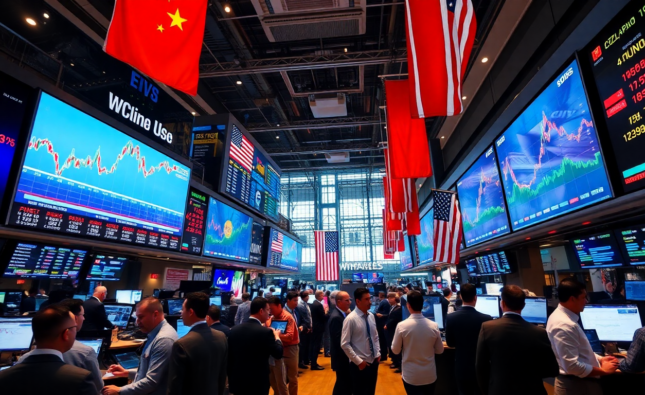
India-US Trade Talks Progress: Roadmap to a $500 Billion Bilateral Trade by 2030
As the global economic landscape continues to evolve, the importance of strategic alliances cannot be overstated. Nowhere is this more evident than in the recent discussions between India and the United States, where leaders have set an ambitious target of boosting bilateral trade to $500 billion by 2030. This marks a significant increase from the $131.84 billion recorded in FY 2024-25, underscoring the potential for deepened economic ties.
Current State of India-US Trade Relations
India and the United States have maintained a robust trade relationship, with the U.S. remaining India’s top trading partner for four consecutive years. In FY 2024-25, India’s exports to the U.S. increased by 11.6%, totaling $86.51 billion. Key exports included drug formulations, telecom instruments, and precious stones. Meanwhile, imports from the U.S. rose by 7.44% to $45.33 billion, focusing primarily on energy resources and machinery.
Strategic Roadmap to $500 Billion Trade Volume by 2030
Under the leadership of Prime Minister Narendra Modi and Vice President JD Vance, a comprehensive roadmap has been outlined to reach the $500 billion bilateral trade target. The India-US Bilateral Trade Agreement (BTA) will focus on addressing tariffs and non-tariff barriers, ensuring a more balanced and reciprocal trade partnership. Furthermore, efforts are being made to strengthen the India-US military partnership technology under the COMPACT initiative, fostering innovation and security in the Indo-Pacific region.
Challenges and Negotiations: Navigating the Trade Terrain
The negotiations are set against the backdrop of historical tariff imbalances, with India’s average applied tariff standing at 17% compared to the U.S.’s 3.3%. The Terms of Reference for ongoing talks aim to rectify these disparities, with particular attention to market access in sectors such as defense and energy. Recent adjustments in U.S. trade policy, including the imposition of a 10% baseline tariff, have catalyzed a reevaluation of trade strategies, as announced during the Trump-Modi meeting.
- Petroleum products remain a cornerstone of U.S. exports to India, alongside coal and machinery.
- Efforts are focusing on reducing India’s tariffs on agricultural products, currently averaging 39%.
- The talks are expected to meticulously address technical and regulatory barriers that hinder U.S. exports.
Political and Economic Implications: A New Era in Bilateral Relations
Beyond the economic implications, this trade partnership holds great promise for political collaboration and regional stability in the Indo-Pacific. The Modi-Vance trade talks have reaffirmed the mutual commitment to a shared vision—Amrit Kaal for India and a Golden Age for America. As negotiations advance, the importance of a unified approach to security, supply chain integration, and sustainable development will remain paramount.
Balancing National Interests with Global Responsibilities
Success in achieving the $500 billion trade target by 2030 will hinge on the balance of national interests with international responsibilities. Both nations are poised to redefine the dynamics of their economic partnership, guided by mutual respect and strategic foresight. As l look forward to the outcomes of the Quad summit and further diplomatic engagements, the potential for enhanced cooperation and prosperity shines with renewed vigor.
Frequently Asked Questions (FAQ)
What is the current aim of the India-US trade agreement?
The current aim is to boost bilateral trade to $500 billion by 2030, surpassing the existing trade volume of $131.84 billion recorded in 2024-25.
What were the highlights of the Modi Vance trade talks?
Highlights included addressing tariff imbalances, setting a strategic roadmap for the $500 billion trade target by 2030, and discussing the Terms of Reference for future negotiations.
How will the Bilateral Trade Agreement between India and the U.S. impact global trade?
The agreement is expected to strengthen economic ties, enhance supply chain integration, and promote regional stability, setting a precedent for international partnerships.
What role did the Trump administration play in India-US trade talks?
The Trump administration’s emphasis on reciprocal tariffs acted as a catalyst for reassessing trade strategies, aiming to establish more equitable trade arrangements.
How significant are recent Terms of Reference in India-US trade negotiations?
They are crucial for achieving a balanced trade partnership by addressing market access barriers, regulatory issues, and ensuring a focus on mutual economic growth.










Comments